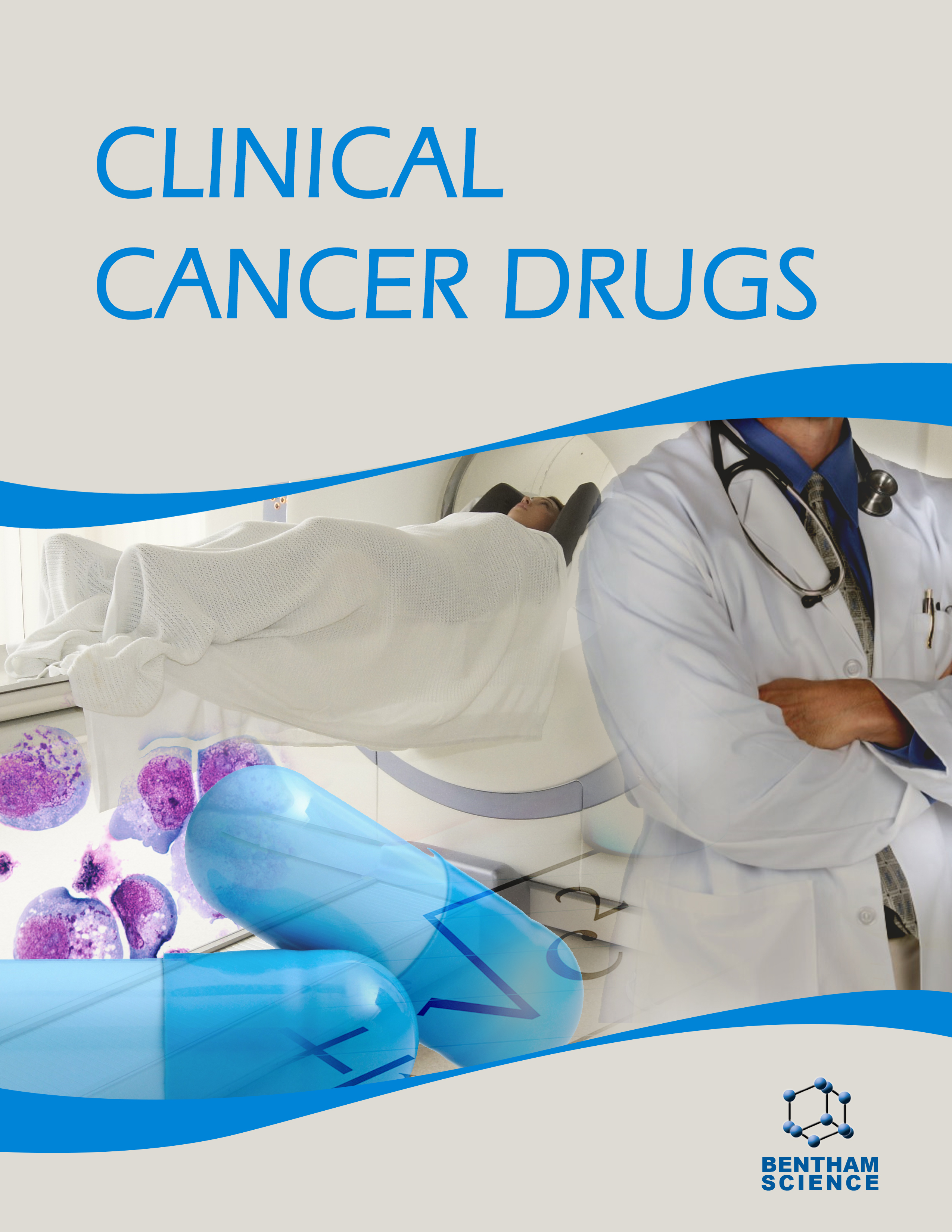- Home
- A-Z Publications
- Clinical Cancer Drugs
- Previous Issues
- Volume 8, Issue 1, 2021
Clinical Cancer Drugs - Volume 8, Issue 1, 2021
Volume 8, Issue 1, 2021
-
-
Role of Erlotinib in Influencing the Quality of Life of Cancer Patients
More LessAuthors: Deepika Purohit and Parijat PandeyBackground: Cancer is one of the significant causes of morbidity and mortality in patients globally. Lung cancer, among other cancers, remains to be one of the principal causes of deaths in both men and women. The most common type of lung cancer is non-small-cell lung cancer (NSCLC). Apart from lung cancer, pancreatic cancer is also currently one of the common cancers. Objective: The assessment of QoL in erlotinib-t Read More
-
-
-
Combining Chemotherapy with Immunotherapy in Colorectal Cancer: A Review
More LessAuthors: John T. Palathingal, Basil Sunny and Vismaya VijayanAmerican Cancer Society estimates that about 1 in 21 men and 1 in 23 women in US will develop colorectal cancer during their lifetime. Due to the advances in screening and treatment modalities, the mortality rate has reduced. Rising resistance to treatment has directed the focus towards different approaches as combination therapies involving different treatment techniques available. One such approach is chemo-immuno Read More
-
-
-
Diarylheptanoids: Potent Anticancer Agents
More LessBy Rabia HameedDiarylheptanoids are widely distributed among species belonging to the family Betulaceae. Being highly polar in nature, they can either be isolated from plants by using sophisticated chromatographic techniques or can be synthesized in the laboratory. They are found to exhibit a wide range of activities, from very simple analgesics to anticancer agents. Recently, they have gained considerable attention due to inhibitory activity Read More
-
-
-
Inhibition of ERN1 Signaling is Important for the Suppression of Tumor Growth
More LessAuthors: Oleksandr H. Minchenko, Dariia O. Tsymbal, Olena O. Khita and Dmytro O. MinchenkoBackground: Endoplasmic reticulum to nucleus signaling 1 (ERN1) is a major signaling pathway of endoplasmic reticulum stress and is crucial for malignant tumor growth. Objective: The article aims to discuss the recent progress in the discovery of endoplasmic reticulum stress targets and their involvement in tumor growth. Methods: Literature from the PubMed database related to the endoplasmic reticulum stress involve Read More
-
-
-
COVID-19 Related Publications Focusing on Cancer: Systematic Review of a Delicate Balance
More LessAuthors: Mahdi F. Naimi, Maira Khan, Mary Mahler and Urban EmmeneggerBackground: The ongoing COVID-19 pandemic has forced oncologists to alter their daily practice, despite the lack of substantial evidence, in order to reduce the risk of transmission among patients with underlying malignant and other concurrent medical conditions. Objective: This systematic review compares the characteristics of oncology-focused COVID-19 manuscripts published from January 1st to April 30th, 2020, and fro Read More
-
-
-
Effect of Ginger Extract on 4T1 Breast Cancer Cell Line in Balb/c Mouse
More LessAuthors: Alireza P. Gholizadeh, Asa Ebrahimi, Mahdi Rahaie and Farzaneh SamieeBackground: By considering [6]-gingerol as an important polyphenol, ginger has been related to cancer. Objective: The main objective of this study is to evaluate the ginger extract on the expressions of four genes from different categories involved in breast cancer in Balb/C mice after 14 days. Methods: In terms of this research, ethanol extraction methods for extracting ginger rhizomes with the goal of increasing [6]-gingerol w Read More
-
-
-
The Antimalarial Drug Pyronaridine Inhibits Topoisomerase II in Breast Cancer Cells and Hinders Tumor Progression In Vivo
More LessBackground: Breast cancer is the most frequently diagnosed cancer in women worldwide. Pyronaridine (PND), an antimalarial drug, was shown to exert anticancer activity on seventeen different human cancer cells, seven from female breast tissue. Additionally, PND induced apoptosis via mitochondrial depolarization, alteration of cell cycle progression, and DNA intercalation. However, the molecular target of PND in cells w Read More
-
-
-
In Silico Based Approach to Investigate Plant Lignans as Inhibitor Candidates for Estrogen Receptor in Breast Cancer
More LessBackground: In the last decades, growing evidence demonstrates interest in phytoestrogen intake to modulate targets in different types of cancer. Plant lignans have proven efficacious in blocking estrogen receptors of breast cancer cells. Among them, four phytoestrogen lignans: pinoresinol, matairesinol, lariciresinol, and secoisolariciresinol have been most studied. However, available studies have mostly dealt with the anti-ca Read More
-
Most Read This Month
Article
content/journals/ccand
Journal
10
5
false
en


